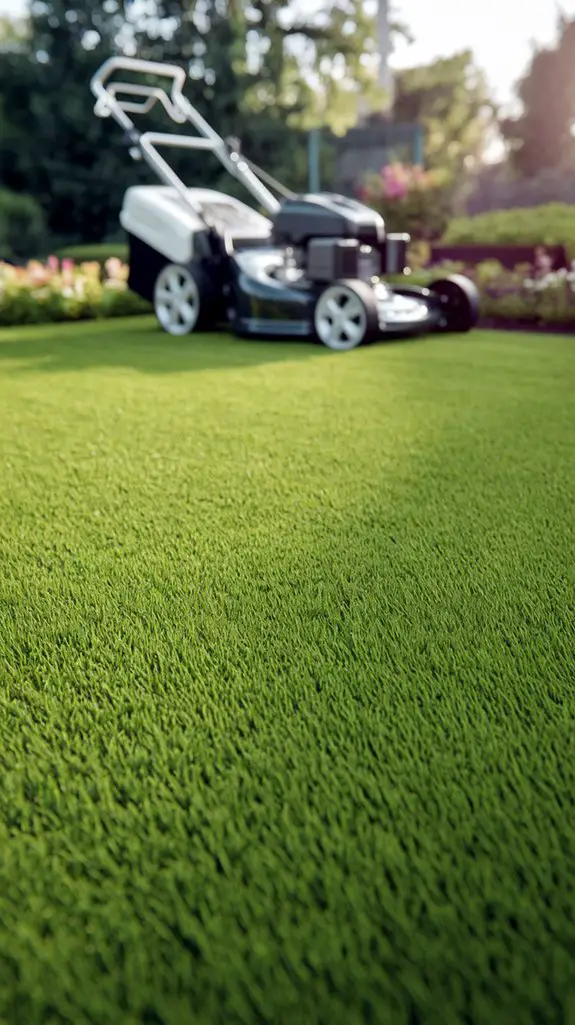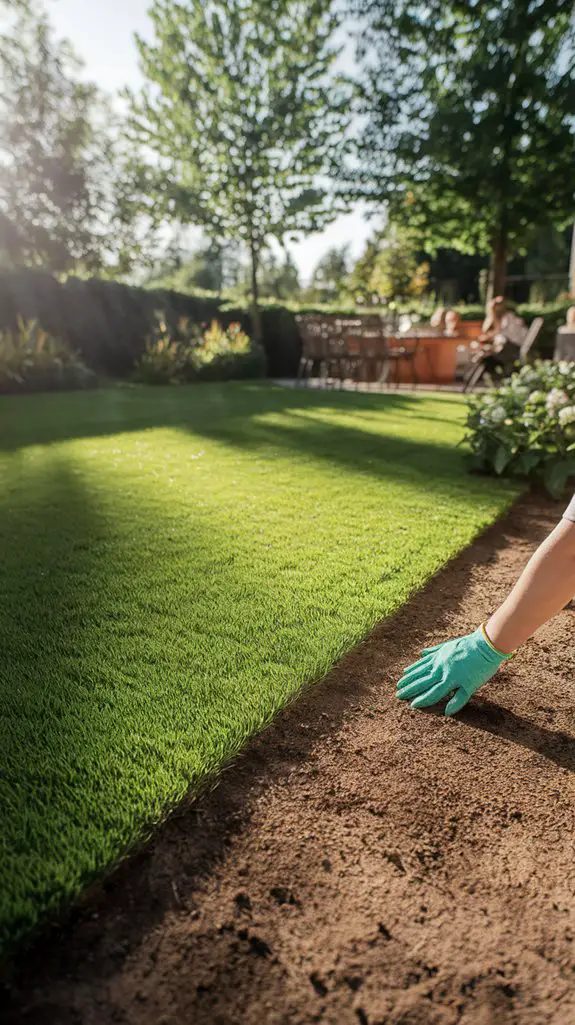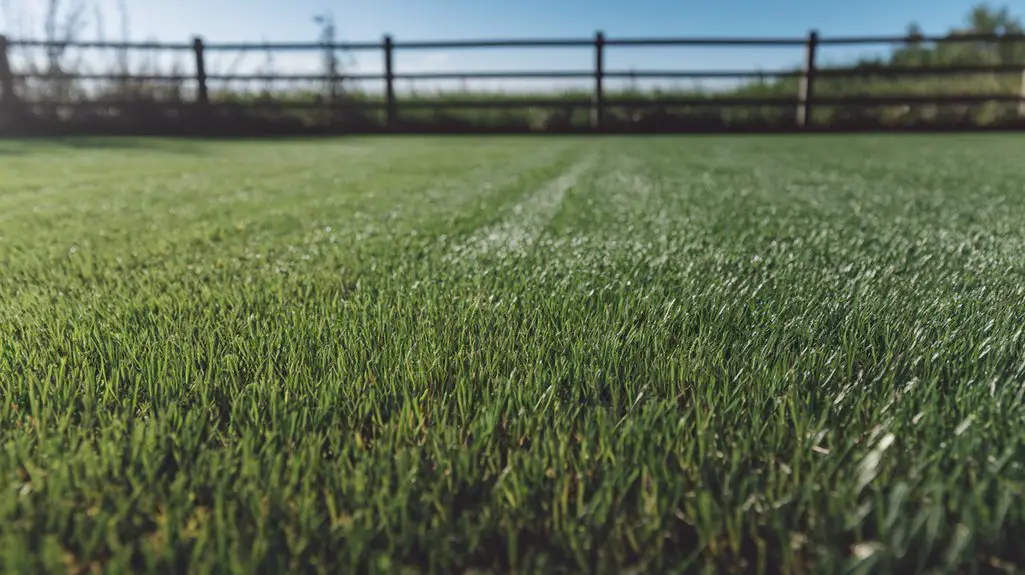You’ve spent months planning your summer BBQ series, but is your lawn ready for the spotlight? A patchy, unhealthy yard can undermine even the most carefully curated gathering. The difference between a good backyard party and a truly memorable one often lies beneath your feet. Your guests might not consciously notice a well-maintained lawn, but they’ll certainly remember an uncomfortable, weed-filled experience. What separates amateur hosts from seasoned entertainers?
Assessing Your Current Lawn Condition
Before hosting the perfect backyard BBQ, you’ll need to take a critical look at your lawn’s current state. Examine your grass for bare patches, discoloration, or excessive weeds that might detract from your gathering’s ambiance.
Note any drainage issues where water pools after rain—these areas can become muddy trouble spots during your event.
Test soil quality by checking its texture and pH level, as these factors determine your lawn’s health and appearance.
Assess sun exposure patterns across your yard to identify high-traffic zones that may need reinforcement before guests arrive.
Don’t overlook existing features like trees or garden beds that could serve as natural focal points or conversation areas.
This thorough evaluation will guide your improvement strategy and help transform your lawn into an ideal entertainment space. Additionally, consider implementing effective lawn care tips to help keep those pesky weeds at bay.
Essential Lawn Mowing Techniques for Event-Ready Grass

When preparing for a successful outdoor event, proper mowing techniques transform an ordinary lawn into a pristine entertainment surface.
Begin by sharpening your mower blades for clean cuts that heal quickly and prevent disease. Set your blade height to 2.5-3.5 inches—taller grass withstands foot traffic better while shading out weeds.
Adopt the one-third rule: never remove more than one-third of grass height in a single mowing.
Two days before your BBQ, mow in overlapping patterns for that professional striped effect. On event day, trim edges with precision tools for defined boundaries.
For barefoot-friendly comfort, rake away clippings thoroughly.
Remember to mow when grass is dry to prevent clumping and guarantee an even cut that’ll impress your guests while providing stable footing for chairs and tables. Additionally, maintaining soil health is crucial for ensuring your lawn remains lush and vibrant throughout the season.
Tackling Bare Spots and Patches Before Your BBQ

Those unsightly bare patches in your lawn can quickly undermine the polished atmosphere of your BBQ gathering, making them a priority for pre-event remediation.
For rapid results, apply a quality patching mix containing seed, fertilizer, and mulch to areas smaller than 6 inches in diameter. Simply rake the spot to remove debris, spread the mix evenly, and water thoroughly.
For larger patches, consider sod placement for instant transformation. Cut the sod precisely to fit the bare area after removing dead grass and loosening the soil beneath. Press firmly into place and water daily until established.
If your event is less than two weeks away, consider strategic furniture placement or decorative mulch islands as temporary solutions that transform eyesores into deliberate design elements. Additionally, incorporating organic materials into your soil can promote healthier grass growth over time.
Strategic Watering to Prepare Your Lawn for Heavy Foot Traffic
Proper hydration represents the foundation of a resilient lawn that can withstand the concentrated foot traffic of your BBQ event.
Begin deep watering 3-4 days before your gathering, delivering 1-1.5 inches of water to encourage deeper root growth. Avoid watering the day before or day of the event—soggy soil compacts easily under foot traffic, damaging roots.
Consider your timing carefully; water in early morning hours (5-9 AM) when evaporation rates are minimal and wind is typically calm.
For precise distribution, install moisture meters at various lawn sections to monitor hydration levels. Focus extra attention on high-traffic pathways between your BBQ station, seating areas, and house entrances, ensuring these zones receive ideal moisture to build maximum resilience. Regular lawn care tips can help maintain a healthy yard even during busy seasons.
Natural Pest Control Methods for Comfortable Outdoor Dining
A well-hydrated lawn provides the perfect foundation for pest management—your next priority for hosting memorable outdoor gatherings.
Deploy citronella torches strategically around your dining area to create an invisible barrier against mosquitoes while adding warm ambient lighting. Scatter dried lavender or rosemary sprigs on serving tables, combining aromatic pleasure with natural insect repellent properties.
Consider planting marigolds, basil, and lemongrass at your lawn’s perimeter—these natural deterrents keep flying insects at bay while enhancing your landscape design. Additionally, incorporating natural herbs into your garden can significantly enhance your pest control efforts.
For immediate results, mix equal parts water and white vinegar to spray boundary areas two hours before guests arrive. Portable fans positioned near food stations create gentle air movement that disrupts flying patterns of gnats and flies, ensuring your guests can enjoy their meals without unwelcome visitors.
Creating Designated Pathways to Protect Your Grass
While protecting your meticulously maintained lawn during high-traffic BBQ events requires thoughtful planning, designated pathways offer an elegant solution that preserves grass health without sacrificing style.
Install temporary stepping stones by placing flat pavers or wood slices at strategic intervals between food stations, seating areas, and play zones.
For a more permanent option, consider crushed stone pathways lined with native plants that complement your landscape design.
Portable outdoor rugs or bamboo mats create instant walkways that you’ll appreciate when guests arrive with plates of food.
Position these pathways to naturally guide traffic flow, preventing concentrated wear patterns on your turf.
Don’t overlook lighting—solar-powered path lights serve the dual purpose of illuminating walkways while subtly encouraging guests to stay on designated routes after sunset. Additionally, incorporating easy lawn care tips into your maintenance routine can enhance the longevity and resilience of your grass.
Setting Up BBQ Zones That Won’t Damage Your Lawn
Creating functional BBQ zones requires strategic planning that balances entertainment needs with lawn preservation.
Position your grill on a heat-resistant surface like concrete pavers or a specialized grill mat to prevent scorched grass and soil compaction. These barriers catch grease splatters while distributing weight evenly across your turf.
For high-traffic serving areas, consider installing temporary interlocking deck tiles that allow airflow to the grass beneath. They’re easily removed post-event, minimizing long-term lawn stress.
Position food and beverage stations under shade trees to reduce foot traffic across your entire yard, concentrating activity in naturally resilient areas.
Always rotate your BBQ setup locations throughout the season, allowing previously used grass sections to recover fully between gatherings.
This circulation strategy maintains your lawn’s overall health while supporting your entertainment needs. Additionally, using creative backyard storage ideas can help keep your BBQ zone organized and clutter-free, enhancing the overall experience for your guests.
Post-Party Lawn Recovery and Care Strategies
After hosting a successful backyard BBQ, your lawn requires immediate attention to recover from the inevitable stress of foot traffic and equipment weight.
Begin by removing all debris and raking areas where grass has been flattened. Water deeply but sparingly to revive compressed soil without causing runoff.
Apply a quarter-inch layer of compost to damaged sections, then overseed bare patches with grass varieties matching your existing lawn.
For severely compacted areas, use a core aerator to restore proper oxygen flow and nutrient absorption. Lawn care tips can also help enhance the overall health of your lawn during recovery.
Consider a light application of balanced fertilizer (10-10-10) to stimulate recovery, but avoid high-nitrogen formulas that cause stress.
Finally, restrict foot traffic on healing areas for at least two weeks, allowing your lawn to fully regenerate before your next outdoor gathering.
Seasonal Lawn Preparations for Summer Entertaining
Successful summer entertaining begins with proactive lawn preparations several weeks before your planned BBQ gatherings. Start by aerating your lawn in early spring to improve root growth and water absorption.
Follow with a balanced slow-release fertilizer application timed 3-4 weeks before your event.
Establish a consistent mowing schedule, keeping grass at 3-3.5 inches during summer months to maintain density while providing drought resistance.
Two days before your BBQ, give your lawn a fresh cut, slightly lower than usual, to create a manicured appearance and discourage pests.
Address thin spots by overseeding six weeks ahead, and manage irrigation strategically—deep watering twice weekly rather than frequent light sprinklings.
This encourages deep root development and guarantees your lawn stays resilient during high-traffic entertaining periods. Additionally, implementing drought-resistant landscaping techniques can further enhance your lawn’s ability to withstand summer heat and conserve water effectively.
Eco-Friendly Lawn Treatments Safe for Food and Guests
When planning your summer BBQ gathering, choosing eco-friendly lawn treatments becomes essential for both environmental responsibility and guest safety.
Opt for organic compost and natural fertilizers derived from bone meal, seaweed, or manure instead of synthetic chemicals that can harm barefoot guests or contaminate food.
Consider corn gluten meal as a pre-emergent herbicide alternative that prevents weed seeds from germinating without introducing toxins. For pest control, introduce beneficial nematodes or ladybugs rather than chemical pesticides.
Water your lawn deeply but infrequently, preferably in early morning, to promote deeper root growth and reduce fungal diseases. Additionally, using organic lawn care practices helps maintain a lush and vibrant lawn while being gentle on the ecosystem.
Install a rain barrel to conserve water while maintaining your lawn’s health. These practices create a safer environment where children can play freely and food can be served without chemical concerns.
Conclusion
Your backyard BBQ success hinges on intentional lawn care planning. Consider the Smith family’s approach—they designated a flagstone area for their grill station and rotated furniture placement throughout summer, preserving their turf’s health. By implementing these targeted strategies, you’ll create a resilient, inviting green space that withstands the season’s gatherings while maintaining its visual appeal. Your lawn isn’t just backdrop—it’s an essential design element to your outdoor entertaining experience.




